[English] 日本語
 Yorodumi
Yorodumi- EMDB-41864: TRPV1 in nanodisc bound with empty vanilloid binding pocket at 4C -
+ Open data
Open data
- Basic information
Basic information
| Entry |  | |||||||||
|---|---|---|---|---|---|---|---|---|---|---|
| Title | TRPV1 in nanodisc bound with empty vanilloid binding pocket at 4C | |||||||||
 Map data Map data | ||||||||||
 Sample Sample |
| |||||||||
 Keywords Keywords | TRPV1 in nanodisc bound with empty vanilloid binding pocket at 4C / MEMBRANE PROTEIN | |||||||||
| Function / homology |  Function and homology information Function and homology informationnegative regulation of establishment of blood-brain barrier / response to capsazepine / sensory perception of mechanical stimulus / peptide secretion / cellular response to temperature stimulus / excitatory extracellular ligand-gated monoatomic ion channel activity / temperature-gated ion channel activity / detection of chemical stimulus involved in sensory perception of pain / TRP channels / smooth muscle contraction involved in micturition ...negative regulation of establishment of blood-brain barrier / response to capsazepine / sensory perception of mechanical stimulus / peptide secretion / cellular response to temperature stimulus / excitatory extracellular ligand-gated monoatomic ion channel activity / temperature-gated ion channel activity / detection of chemical stimulus involved in sensory perception of pain / TRP channels / smooth muscle contraction involved in micturition / fever generation / urinary bladder smooth muscle contraction / detection of temperature stimulus involved in thermoception / thermoception / cellular response to acidic pH / negative regulation of systemic arterial blood pressure / chloride channel regulator activity / response to pH / dendritic spine membrane / glutamate secretion / monoatomic cation transmembrane transporter activity / cellular response to ATP / negative regulation of heart rate / ligand-gated monoatomic ion channel activity / response to pain / cellular response to alkaloid / temperature homeostasis / diet induced thermogenesis / cellular response to cytokine stimulus / detection of temperature stimulus involved in sensory perception of pain / intracellularly gated calcium channel activity / behavioral response to pain / negative regulation of mitochondrial membrane potential / calcium ion import across plasma membrane / monoatomic cation channel activity / extracellular ligand-gated monoatomic ion channel activity / sensory perception of pain / phosphatidylinositol binding / phosphoprotein binding / microglial cell activation / cellular response to nerve growth factor stimulus / calcium ion transmembrane transport / GABA-ergic synapse / calcium channel activity / cellular response to growth factor stimulus / response to peptide hormone / lipid metabolic process / positive regulation of nitric oxide biosynthetic process / calcium ion transport / transmembrane signaling receptor activity / cellular response to tumor necrosis factor / sensory perception of taste / cellular response to heat / positive regulation of cytosolic calcium ion concentration / response to heat / monoatomic ion transmembrane transport / protein homotetramerization / postsynaptic membrane / neuron projection / calmodulin binding / positive regulation of apoptotic process / external side of plasma membrane / neuronal cell body / dendrite / negative regulation of transcription by RNA polymerase II / ATP binding / metal ion binding / identical protein binding / membrane / plasma membrane Similarity search - Function | |||||||||
| Biological species |  | |||||||||
| Method | single particle reconstruction / cryo EM / Resolution: 2.9 Å | |||||||||
 Authors Authors | Arnold WR / Julius D / Cheng Y | |||||||||
| Funding support |  United States, 2 items United States, 2 items
| |||||||||
 Citation Citation |  Journal: Nat Struct Mol Biol / Year: 2024 Journal: Nat Struct Mol Biol / Year: 2024Title: Structural basis of TRPV1 modulation by endogenous bioactive lipids. Authors: William R Arnold / Adamo Mancino / Frank R Moss / Adam Frost / David Julius / Yifan Cheng /  Abstract: TRP ion channels are modulated by phosphoinositide lipids, but the underlying structural mechanisms remain unclear. The capsaicin- and heat-activated receptor, TRPV1, has served as a model for ...TRP ion channels are modulated by phosphoinositide lipids, but the underlying structural mechanisms remain unclear. The capsaicin- and heat-activated receptor, TRPV1, has served as a model for deciphering lipid modulation, which is relevant to understanding how pro-algesic agents enhance channel activity in the setting of inflammatory pain. Identification of a pocket within the TRPV1 transmembrane core has provided initial clues as to how phosphoinositide lipids bind to and regulate the channel. Here we show that this regulatory pocket in rat TRPV1 can accommodate diverse lipid species, including the inflammatory lipid lysophosphatidic acid, whose actions are determined by their specific modes of binding. Furthermore, we show that an empty-pocket channel lacking an endogenous phosphoinositide lipid assumes an agonist-like state, even at low temperature, substantiating the concept that phosphoinositide lipids serve as negative TRPV1 modulators whose ejection from the binding pocket is a critical step toward activation by thermal or chemical stimuli. | |||||||||
| History |
|
- Structure visualization
Structure visualization
| Supplemental images |
|---|
- Downloads & links
Downloads & links
-EMDB archive
| Map data |  emd_41864.map.gz emd_41864.map.gz | 248.4 MB |  EMDB map data format EMDB map data format | |
|---|---|---|---|---|
| Header (meta data) |  emd-41864-v30.xml emd-41864-v30.xml emd-41864.xml emd-41864.xml | 19.2 KB 19.2 KB | Display Display |  EMDB header EMDB header |
| FSC (resolution estimation) |  emd_41864_fsc.xml emd_41864_fsc.xml | 13.7 KB | Display |  FSC data file FSC data file |
| Images |  emd_41864.png emd_41864.png | 72.6 KB | ||
| Filedesc metadata |  emd-41864.cif.gz emd-41864.cif.gz | 6.6 KB | ||
| Others |  emd_41864_half_map_1.map.gz emd_41864_half_map_1.map.gz emd_41864_half_map_2.map.gz emd_41864_half_map_2.map.gz | 254.9 MB 254.9 MB | ||
| Archive directory |  http://ftp.pdbj.org/pub/emdb/structures/EMD-41864 http://ftp.pdbj.org/pub/emdb/structures/EMD-41864 ftp://ftp.pdbj.org/pub/emdb/structures/EMD-41864 ftp://ftp.pdbj.org/pub/emdb/structures/EMD-41864 | HTTPS FTP |
-Validation report
| Summary document |  emd_41864_validation.pdf.gz emd_41864_validation.pdf.gz | 880.4 KB | Display |  EMDB validaton report EMDB validaton report |
|---|---|---|---|---|
| Full document |  emd_41864_full_validation.pdf.gz emd_41864_full_validation.pdf.gz | 879.9 KB | Display | |
| Data in XML |  emd_41864_validation.xml.gz emd_41864_validation.xml.gz | 23.1 KB | Display | |
| Data in CIF |  emd_41864_validation.cif.gz emd_41864_validation.cif.gz | 29.9 KB | Display | |
| Arichive directory |  https://ftp.pdbj.org/pub/emdb/validation_reports/EMD-41864 https://ftp.pdbj.org/pub/emdb/validation_reports/EMD-41864 ftp://ftp.pdbj.org/pub/emdb/validation_reports/EMD-41864 ftp://ftp.pdbj.org/pub/emdb/validation_reports/EMD-41864 | HTTPS FTP |
-Related structure data
| Related structure data |  8u3jMC 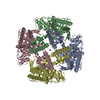 8t0cC 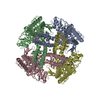 8t0eC 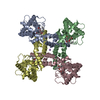 8t0yC 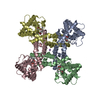 8t10C 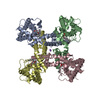 8t3lC 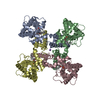 8t3mC 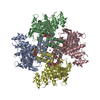 8u2zC 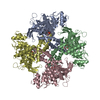 8u30C 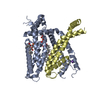 8u3aC 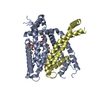 8u3cC  8u3lC  8u43C 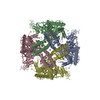 8u4dC M: atomic model generated by this map C: citing same article ( |
|---|---|
| Similar structure data | Similarity search - Function & homology  F&H Search F&H Search |
- Links
Links
| EMDB pages |  EMDB (EBI/PDBe) / EMDB (EBI/PDBe) /  EMDataResource EMDataResource |
|---|---|
| Related items in Molecule of the Month |
- Map
Map
| File |  Download / File: emd_41864.map.gz / Format: CCP4 / Size: 274.6 MB / Type: IMAGE STORED AS FLOATING POINT NUMBER (4 BYTES) Download / File: emd_41864.map.gz / Format: CCP4 / Size: 274.6 MB / Type: IMAGE STORED AS FLOATING POINT NUMBER (4 BYTES) | ||||||||||||||||||||||||||||||||||||
|---|---|---|---|---|---|---|---|---|---|---|---|---|---|---|---|---|---|---|---|---|---|---|---|---|---|---|---|---|---|---|---|---|---|---|---|---|---|
| Projections & slices | Image control
Images are generated by Spider. | ||||||||||||||||||||||||||||||||||||
| Voxel size | X=Y=Z: 0.68 Å | ||||||||||||||||||||||||||||||||||||
| Density |
| ||||||||||||||||||||||||||||||||||||
| Symmetry | Space group: 1 | ||||||||||||||||||||||||||||||||||||
| Details | EMDB XML:
|
-Supplemental data
-Half map: #2
| File | emd_41864_half_map_1.map | ||||||||||||
|---|---|---|---|---|---|---|---|---|---|---|---|---|---|
| Projections & Slices |
| ||||||||||||
| Density Histograms |
-Half map: #1
| File | emd_41864_half_map_2.map | ||||||||||||
|---|---|---|---|---|---|---|---|---|---|---|---|---|---|
| Projections & Slices |
| ||||||||||||
| Density Histograms |
- Sample components
Sample components
-Entire : TRPV1 in nanodisc with empty vanilloid binding pocket at 4C
| Entire | Name: TRPV1 in nanodisc with empty vanilloid binding pocket at 4C |
|---|---|
| Components |
|
-Supramolecule #1: TRPV1 in nanodisc with empty vanilloid binding pocket at 4C
| Supramolecule | Name: TRPV1 in nanodisc with empty vanilloid binding pocket at 4C type: complex / ID: 1 / Parent: 0 / Macromolecule list: #1 |
|---|---|
| Source (natural) | Organism:  |
| Molecular weight | Theoretical: 688 KDa |
-Macromolecule #1: Transient receptor potential cation channel subfamily V member 1
| Macromolecule | Name: Transient receptor potential cation channel subfamily V member 1 type: protein_or_peptide / ID: 1 / Number of copies: 4 / Enantiomer: LEVO |
|---|---|
| Source (natural) | Organism:  |
| Molecular weight | Theoretical: 61.557422 KDa |
| Recombinant expression | Organism:  Homo sapiens (human) Homo sapiens (human) |
| Sequence | String: SYYKGQTALH IAIERRNMTL VTLLVENGAD VQAAANGDFF KKTKGRPGFY FGELPLSLAA CTNQLAIVKF LLQNSWQPAD ISARDSVGN TVLHALVEVA DNTVDNTKFV TSMYNEILIL GAKLHPTLKL EEITNRKGLT PLALAASSGK IGVLAYILQR E IHEPECRH ...String: SYYKGQTALH IAIERRNMTL VTLLVENGAD VQAAANGDFF KKTKGRPGFY FGELPLSLAA CTNQLAIVKF LLQNSWQPAD ISARDSVGN TVLHALVEVA DNTVDNTKFV TSMYNEILIL GAKLHPTLKL EEITNRKGLT PLALAASSGK IGVLAYILQR E IHEPECRH LSRKFTEWAY GPVHSSLYDL SCIDTCEKNS VLEVIAYSSS ETPNRHDMLL VEPLNRLLQD KWDRFVKRIF YF NFFVYCL YMIIFTAAAY YRPVEGLPPY KLKNTVGDYF RVTGEILSVS GGVYFFFRGI QYFLQRRPSL KSLFVDSYSE ILF FVQSLF MLVSVVLYFS QRKEYVASMV FSLAMGWTNM LYYTRGFQQM GIYAVMIEKM ILRDLCRFMF VYLVFLFGFS TAVV TLIED GKYNSLYSTC LELFKFTIGM GDLEFTENYD FKAVFIILLL AYVILTYILL LNMLIALMGE TVNKIAQESK NIWKL QRAI TILDTEKSFL KCMRKAFRSG KLLQVGFTPD GKDDYRWCFR VDEVNWTTWN UniProtKB: Transient receptor potential cation channel subfamily V member 1 |
-Macromolecule #2: 1,2-DIACYL-GLYCEROL-3-SN-PHOSPHATE
| Macromolecule | Name: 1,2-DIACYL-GLYCEROL-3-SN-PHOSPHATE / type: ligand / ID: 2 / Number of copies: 4 / Formula: 3PH |
|---|---|
| Molecular weight | Theoretical: 704.998 Da |
| Chemical component information | 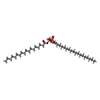 ChemComp-3PH: |
-Macromolecule #3: SODIUM ION
| Macromolecule | Name: SODIUM ION / type: ligand / ID: 3 / Number of copies: 1 |
|---|---|
| Molecular weight | Theoretical: 22.99 Da |
-Macromolecule #4: water
| Macromolecule | Name: water / type: ligand / ID: 4 / Number of copies: 4 / Formula: HOH |
|---|---|
| Molecular weight | Theoretical: 18.015 Da |
| Chemical component information |  ChemComp-HOH: |
-Experimental details
-Structure determination
| Method | cryo EM |
|---|---|
 Processing Processing | single particle reconstruction |
| Aggregation state | particle |
- Sample preparation
Sample preparation
| Concentration | 2.1 mg/mL |
|---|---|
| Buffer | pH: 7.5 |
| Vitrification | Cryogen name: ETHANE |
- Electron microscopy
Electron microscopy
| Microscope | FEI TITAN KRIOS |
|---|---|
| Image recording | Film or detector model: GATAN K3 BIOQUANTUM (6k x 4k) / Average electron dose: 60.0 e/Å2 |
| Electron beam | Acceleration voltage: 300 kV / Electron source:  FIELD EMISSION GUN FIELD EMISSION GUN |
| Electron optics | Illumination mode: SPOT SCAN / Imaging mode: BRIGHT FIELD / Nominal defocus max: 2.0 µm / Nominal defocus min: 0.8 µm |
| Experimental equipment |  Model: Titan Krios / Image courtesy: FEI Company |
 Movie
Movie Controller
Controller


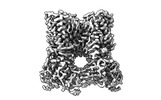















 X (Sec.)
X (Sec.) Y (Row.)
Y (Row.) Z (Col.)
Z (Col.)






































